Three offers 5G home broadband with an average download speed of 150Mbps. Find out how it compares to normal fibre broadband.
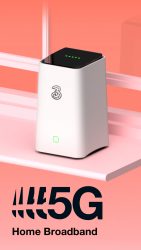 In the UK, Three now offers unlimited 5G home broadband in selected postcodes across 580 UK towns and cities.
In the UK, Three now offers unlimited 5G home broadband in selected postcodes across 580 UK towns and cities.
One of the benefits of Three’s 5G home broadband is that it’s a cheaper option than most fibre broadband services. The average download speed of 150Mbps also holds up well, though the greater variability in download speeds can be frustrating and can be a deal-breaker for some.
As a special offer for December 2025, you can get Three’s 5G home broadband for just £15 per month when you order through this link (this is reduced from £21 per month). Alternatively, if you’re looking for a shorter contract, there’s a 12-month plan where you’ll pay £24 per month.
In this article, we’ll review Three’s 5G home broadband. We’ll start by looking at how it works, and how it compares to normal fibre broadband. We’ll also look at the speeds available, along with the best 5G home broadband deals and the latest 5G Hub router.
| Prices From: | £15 per month |
|---|---|
| Contract Length: | 1 month or 24 month contract |
| Download Speed: | 150Mbps average Will vary based on the signal strength & coverage in your area |
| Router: | Three 5G Hub |
| Coverage: | Selected UK postcodes with 5G coverage (check your postcode) |
Contents
What is Three 5G Home Broadband?
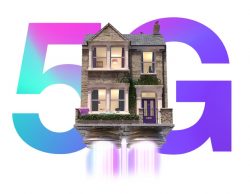 In the UK, Three’s 5G home broadband is an alternative way of getting high-speed broadband internet in your home. Currently available from £15 per month, it offers average download speeds of 150Mbps. This is possible without the need for you to have a landline, or to have a fibre optic connection in your home.
In the UK, Three’s 5G home broadband is an alternative way of getting high-speed broadband internet in your home. Currently available from £15 per month, it offers average download speeds of 150Mbps. This is possible without the need for you to have a landline, or to have a fibre optic connection in your home.
Advantages of 5G Home Broadband
Compared to normal fibre broadband, there are a number of key advantages to getting 5G home broadband:
- Three’s 5G home broadband is fast and easy to set up. It’s a simple plug-and-play setup process with Three’s 5G home broadband. All you need to do is to plug in the 5G Hub at the wall. You’re then ready to connect to the wi-fi network, to get your devices online. There’s also next working day delivery included for your Hub. In contrast, it can take about 2 weeks to get fibre broadband set up in your home.
- It’s flexible, so you can bring it elsewhere. Flexibility is a major feature of Three’s 5G home broadband. For instance, if you’re going away for the weekend, you can simply bring the 5G Hub and your broadband connection will travel with you. It’s also good if you’re planning to move home in the near future, or if you’re living in a shared household (e.g. students or sharers).
- It’s cheaper than normal fibre broadband, and offers faster download speeds. In general, Three’s 5G home broadband is cheaper than most fibre broadband plans. It also offers faster download speeds on average (albeit, with much more variability).
Disadvantages of 5G Home Broadband
On the other hand, there are some significant disadvantages to 5G home broadband technology as well:
- The speeds are inconsistent and the service is susceptible to slowdowns. This is the main drawback of Three’s 5G home broadband. During daily use, you’ll see the download speeds varying significantly. This can be for a variety of reasons including the weather, and other people using the service in your area. It’s worth dwelling on this in a lot more detail as this can be a significant drawback, depending on your requirements (see the section below for a more in-depth discussion).
- Three’s 5G home broadband is only available in selected postcodes. You’ll only be able to get Three’s 5G home broadband is selected postcodes across the UK. This is because Three only offers their 5G home broadband service in areas where they think there is sufficient coverage and network capacity. As such, there are locations where you’re able to get a 5G service on your mobile phone but where you’re unable to get 5G home broadband at present.
- It’s slower than full fibre (FTTP) broadband. If you’re able to get full fibre (FTTP) broadband in your home, this will be a lot faster and more consistent than 5G home broadband. Full fibre technology is now available in more than 30% of UK homes so this might be a better option if you’re able to get it where you live.
How Does Three’s 5G Home Broadband Work?
To fully appreciate the advantages and the disadvantages of the service, it’s worth understanding how the service works in more detail.
With 5G home broadband, there’s a fibre optic connection from the telephone exchange to your nearest 5G mast (this is known as the ‘backhaul’ connection). From there, a 5G mobile signal is used to deliver the broadband service into your home. As such, the download speeds will vary based on the quality of your 5G mobile signal, as well as the number of other people using the service in your area. That’s because there’s only a finite amount of radio spectrum being shared by users on each mast. In addition, the ‘backhaul’ fibre optic connection is shared with other users on the mast (there’s typically either a 1Gbps or 10Gbps backhaul connection to be shared by all users on one mast).
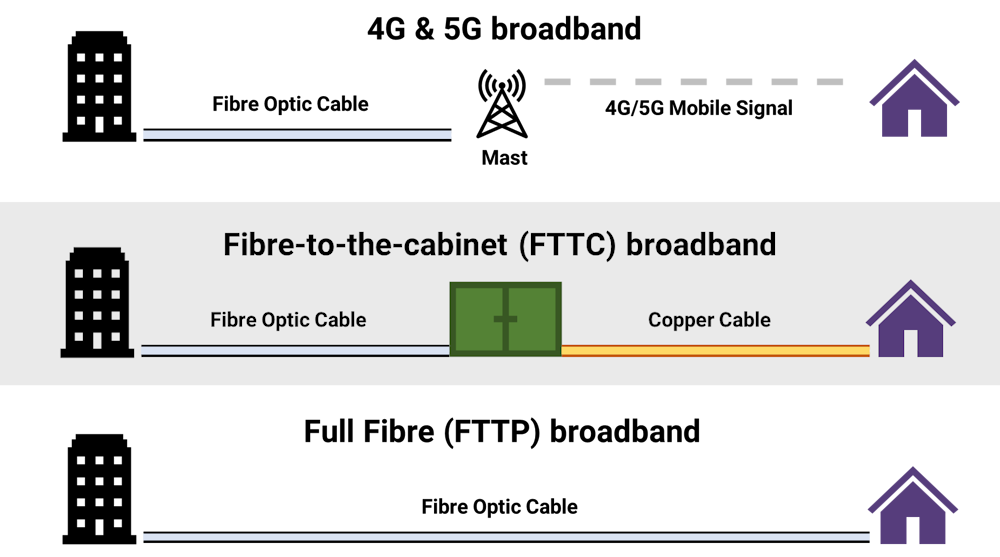
With regular fibre broadband (also known as fibre-to-the-cabinet, or FTTC broadband), there’s a fibre optic connection from the telephone exchange to a street cabinet near your home. The final part of the connection is delivered over a copper cable, where the speeds will degrade with distance. For instance, it might be possible to get 80Mbps if you live next to the cabinet, but only 40Mbps if you live 500 metres away. In general, your download speeds will be fairly consistent as it’s mainly dependent on the length of the copper line into your home.
Finally, with full fibre broadband (also known as fibre-to-the-premises, or FTTP broadband), there’s a dedicated fibre optic connection all the way from the telephone exchange to your home. As such, you’ll be able to get up to gigabit speeds. This is possible without any slowdown and without the need to share your connection with other users. You’ll therefore get the most consistent speed with this technology.
All of this is summarised in the following table:
| Three 5G Broadband | Fibre-to-the-cabinet (FTTC) | Full Fibre (FTTP) | |
|---|---|---|---|
| Average Speed: | 150Mbps | Up to 80Mbps | Up to 1Gbps |
| Speed varies based on: |
|
Length of copper line | No significant factors |
| Speeds over time: | Highly variable speeds | Consistent speeds | Very consistent speeds |
| Connection Type: | Fibre-to-the-mast + 5G wireless |
Fibre-to-the-cabinet + copper cable |
Fibre-to-the-premises |
Is Three’s 5G Home Broadband Any Good?
 The answer is it really depends on your location and how you use your home broadband service.
The answer is it really depends on your location and how you use your home broadband service.
In terms of pricing and flexibility, Three’s 5G home broadband is fairly difficult to beat. You’re normally going to be paying more than £24 per month to get a fibre broadband service elsewhere, with slower download speeds on average compared to Three’s 5G home broadband.
Download Speeds Can Vary A Lot
The caveat is that you’re getting much more variable speeds on Three’s 5G home broadband, and that might be a problem, depending on your household’s bandwidth requirements.
To illustrate, it’s worth knowing that you’ll need about 5Mbps to stream or video call in HD quality on each device (25Mbps in Ultra HD quality). You’ll need to multiply this up by the number of devices you have. For instance, you’ll need a download speed of 50Mbps if you’re streaming Ultra HD video on two devices at the same time. For a smooth experience, you’ll need to maintain a download speed of at least 50Mbps at all times.
This relates very much to the variable nature of Three’s 5G home broadband. In our own testing, we found download speeds varying from 80Mbps to 500Mbps. In this situation, I’d probably think of it as an 80Mbps connection, with the ‘bonus’ of being able to get faster speeds at certain times. That’s because if you were to actually need more than 80Mbps on an regular basis, there would be quite a lot of frustration from drop-outs and buffering, whenever the speed of your connection drops below 80Mbps.
The following graph shows how the download speeds vary over time on Three’s 5G home broadband:
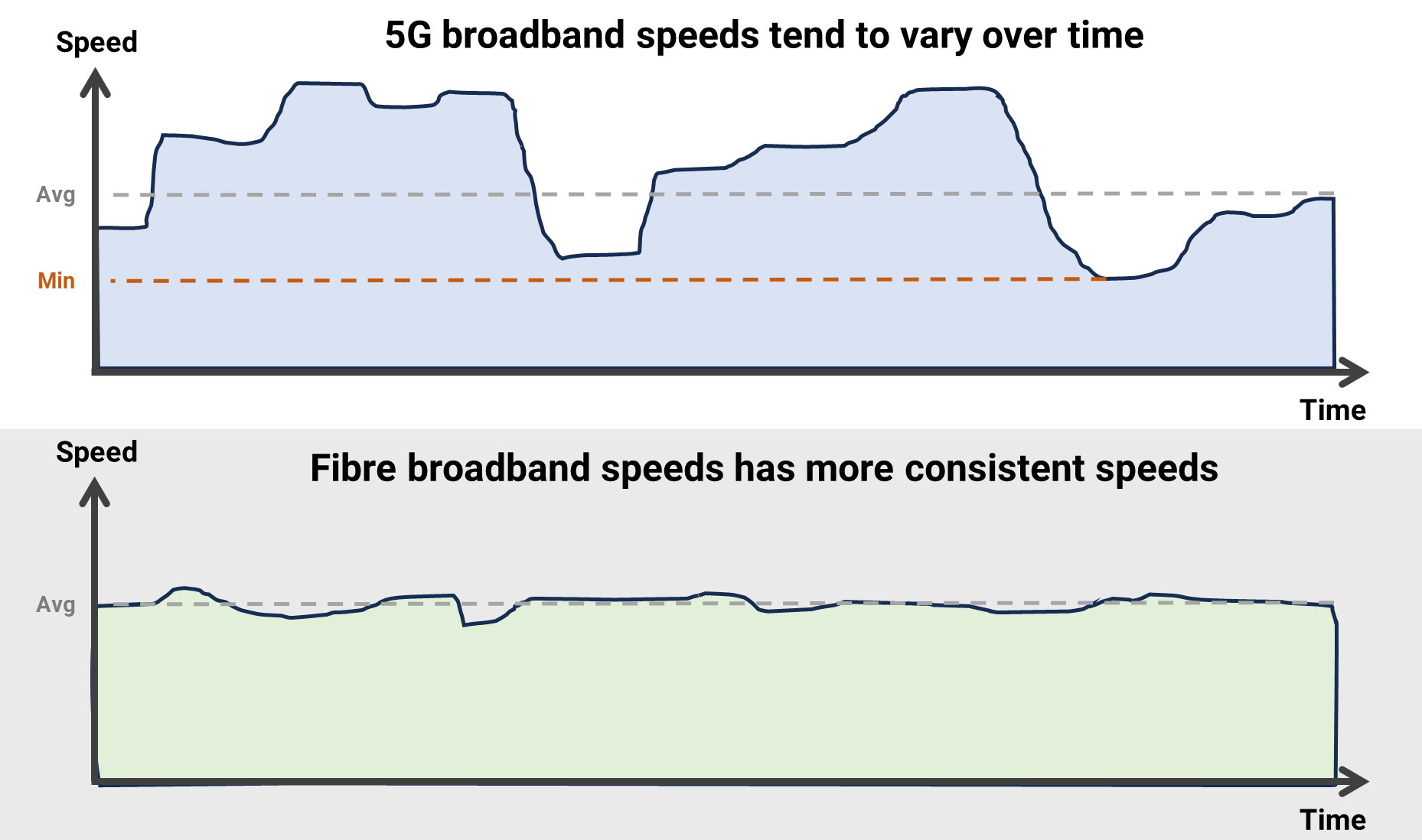
Reading around, how much of a problem this is really depends on where you live. For instance, customers in some areas report their download speed dropping to 20Mbps at times. This is likely to give you a frustrating experience if you’re streaming anything online. In contrast, other customers say their download speeds rarely drop below 100Mbps.
Of course, how your speeds vary over time will depend on a lot of different factors. This includes where you’re located, the quality of your 5G signal, and the number of other users in your area. For this reason, you really need to try it out for yourself to get a feel of what the speeds are like and whether this meets your requirements. Thankfully, there’s a 30-day money back guarantee available, so you can try it out for yourself without any risk.
Conclusions
In our opinion, Three’s 5G home broadband has really clear benefits if you’re in one of the following groups:
- If you’re unable to get good speeds through normal fibre broadband. If you’re not able to get good speeds through a fibre broadband connection (or if you’re only able to get copper/ADSL broadband), it’s likely you’ll have a better experience with 5G home broadband.
- If you’re looking for cheap broadband & are happy to accept some variability in speeds. With Three’s 5G home broadband, you’ll save compared to normal fibre broadband. In addition, the variability in download speeds doesn’t need to be a deal-breaker for everyone – especially if you’re only using a handful of devices at a time.
- If you’re looking for flexible broadband that’s easy to set up. There are no engineer visits and you can even bring it with you to another location (e.g. on a trip away for the weekend, or if you’re moving home).
In contrast, it’s worth thinking twice if you belong to one of the following groups:
- If you’re in a busy household with lots of connected devices. In general, you’ll get a far more consistent experience with fibre broadband or full fibre broadband. That’s going to give you a much more dependable experience when you’re streaming online video, working from home, playing games, etc.
- If you’re in a household with access to full fibre (FTTP) broadband. Although 5G home broadband can be competitive in speed with fibre-to-the-cabinet (FTTC) broadband, it doesn’t come anywhere close to full fibre (FTTP) technology in speeds.
Best Three 5G Broadband Deals
 In the UK, Three currently offers a choice of the following 5G home broadband plans:
In the UK, Three currently offers a choice of the following 5G home broadband plans:
- Home BB 24M Unlimited 5G. If you sign up to Three’s 5G home broadband on a 24-month contract, you’ll pay £15 per month. This is available when you order through this link. There’s a 30-day money back guarantee on this plan.
- Home BB 12M Unlimited 5G. If you’re looking for more flexibility, you’ll pay £24 per month on a 12-month plan.
Both plans will give you unlimited data with average download speeds of about 150Mbps. There’s no upfront fee on either plan and you’ll receive the same 5G Hub router from Three.
| Service | Data | Monthly Cost (will rise each April by £3.50) |
|
|---|---|---|---|
Three 5G Hub | Unlimited data 150Mbps average speed | £15.00 per month No upfront fee 24 month contract | See deal |
Three 5G Hub | Unlimited data 150Mbps average speed | £24.00 per month No upfront fee 12 month contract | See deal |
Three 5G Hub Router
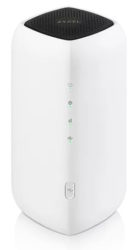 When you sign up for Three’s 5G home broadband, you’ll receive their 5G Hub router. This is a small device that you’ll need to plug in to a power socket inside your home. It picks up a 5G signal from Three’s network and converts it into a regular wi-fi network that your other devices can use.
When you sign up for Three’s 5G home broadband, you’ll receive their 5G Hub router. This is a small device that you’ll need to plug in to a power socket inside your home. It picks up a 5G signal from Three’s network and converts it into a regular wi-fi network that your other devices can use.
Three’s latest 5G Hub router supports a maximum download speed of 4.7Gbps (4,700Mbps). In practice, however, the average speeds will be more like 100-200Mbps on today’s 5G networks.
The 5G Hub supports the latest Wi-Fi 6 technology (802.11a/b/g/n/ac/ax), allowing you to share your home broadband connection with up to 64 devices. In addition, there are two Gigabit Ethernet sockets, allowing you to connect wired devices to your home network.
In terms of how your other devices interact with the 5G Hub, it’s no different to using a traditional fibre broadband service. Your 5G Hub router plays the same role as a traditional fibre broadband router and produces a regular wi-fi network that your other devices can connect to. This includes your laptop, tablet, smartphone, smart TV, games console and other smart home devices. You can also use all of the normal apps and services that you’re used to.
The 5G Hub router can also be attached to a mesh wi-fi system (e.g. the Amazon eero, Nest WiFi, Whole Home WiFi or TP-Link Deco) in the normal way. If you like, Three offers the Amazon eero as an optional add-on to their plans, but this is only available if you call them up or if you visit them in store.
The following table shows the technical specifications of Three’s 5G Hub router:
| Three 5G Hub (Zyxel NR5103E v2) | |
|---|---|
 | |
| Home Broadband Plans | |
| Price: | From £15/month |
| Data: | Unlimited |
| Unlimited Data: | £15/month |
| Contract Length: | 12-24 months |
| Mobile Connectivity | |
| 5G Connectivity: | Up to 4700 Mbps download |
| 5G Bands: | 5G NR bands TBC |
| 4G Download Speed: | Up to 1600 Mbps download |
| 4G Bands: | LTE bands TBC |
| External Antenna: | Yes, 2x TS-9 connectors |
| Home Network Connectivity | |
| Dual-Band Wi-Fi: | Yes |
| Wi-Fi Connectivity: | 802.11a/b/ |
| Wi-Fi Devices: | Up to 64 devices |
| Ethernet: | 2 Gigabit Ethernet ports |
| Other | |
| Dimensions: | 20.0 x 27.0 x 13.4 cm |
| Model: | Zyxel NR5103E v2 |
| Colour: | White |
| More Information: | See three.co.uk |
Three’s latest 5G Hub router is the Zyxel NR5103E V2. This launched in 2024.
If you signed up to Three’s 5G home broadband service before this date, you might have an older version of the 5G Hub. In the past, customers have received the ZTE MC888 (2024), the Zyxel NR5103E (September 2022 – November 2023), the ZTE MC801A (February 2022 – September 2022), and the Huawei 5G CPE Pro H112-370 (prior to February 2022). All of these routers are branded as the ‘5G Hub’.
When you cancel your Three Broadband service, you’ll need to return the 5G Hub router to Three.
Frequently Asked Questions
| How much does Three’s 5G home broadband cost? | Three’s 5G home broadband service is currently available on a choice of two plans:
Both plans come with unlimited data and average download speeds of 150Mbps. |
|---|---|
| What is Three’s 5G Hub router? | You’ll be supplied with Three’s 5G Hub router when you sign up for 5G home broadband. This is a plug-and-play device that connects to Three’s 5G network, broadcasting a wi-fi signal from it that your other devices can connect to.
The 5G Hub support download speeds of up to 4,700Mbps on 5G. It also supports Wi-Fi 6 connectivity (802.11a/b/g/n/ac/ax) on up to 64 devices at the same time. It has two Gigabit Ethernet sockets, allowing you to connect wired devices to your home network. You can see more information about the 5G Hub on Three’s website. |
| How does 5G home broadband compare to fibre broadband? | Three’s 5G home broadband service offers average download speeds of 150Mbps. It’s also cheaper and more flexible than most fibre broadband plans.
The main drawback is that you’re getting highly variable speeds, with fluctuations due to a number of reasons such as the weather, the coverage, and other users in your area. This can make for a frustrating experience if you’re streaming on multiple devices at the same time. |
| Are there any download limits on Three’s 5G home broadband? | No. There are no download limits on Three’s 5G home broadband. However, they say they reserve the right to suspend your service or to apply traffic management to it if your usage “either exceeds that reasonably expected of someone using the Service or materially affects other users’ enjoyment of the Service, or has an adverse impact on our network”. |
| Can I get Three’s 5G home broadband where I live? | Three’s 5G home broadband service is now available in selected postcodes across 580 UK towns and cities. You can enter your address on Three’s website to see whether 5G broadband is available where you live. |
More Information
For more information about Three’s 5G home broadband, please see their official website.
You can also read our Three Broadband review and our guide to 5G home broadband in the UK.


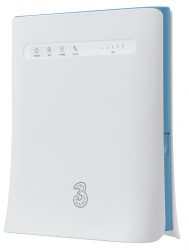
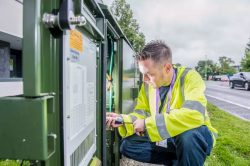

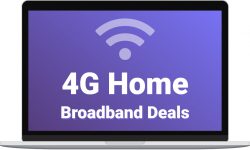

Robert Davies said:
if you have trouble either getting a strong signal with 5g does it automatically go on the 4g signal so you can still browse the Internet.
Ken replied:
Hi Robert,
Thanks for your comment. Yes, it will automatically drop back down to 4G, should it lose a 5G signal.
Hope this helps,
Ken
Steven Bee said:
The maximum devices supported by the Three 5G Broadband hub model NR5103EV2 is 32, NOT 64. I found out the hard way after ordering Three 5G Home Broadband. Note that the Three 4G router does support 64 devices. A bit odd having less supported devices on what you’d think to be a more capable 5G device.
Steve said:
I took the plunge and ditched Virgin when they ramped up their prices. I saw on the Three website that I was in a marginal area for 5G so tried a Smarty Sim. First time I used Speedtest I got 700Mbps d/l and 70mbps u/l. I bought the device over the counter here in Edinburgh. The speeds never less than about 550Mbps an often up to 850Mbps. At my dad’s place I was getting 1100Mbps on my Oneplus phone. If you can get a decent signal it’s a no-brainer, I’m just dreading if the proposed merger with Vodafone get given the green light as I’ve had nothing but hassle with them 😦